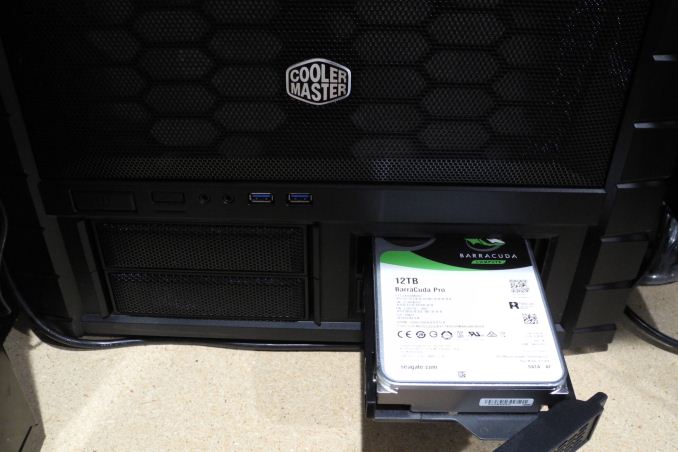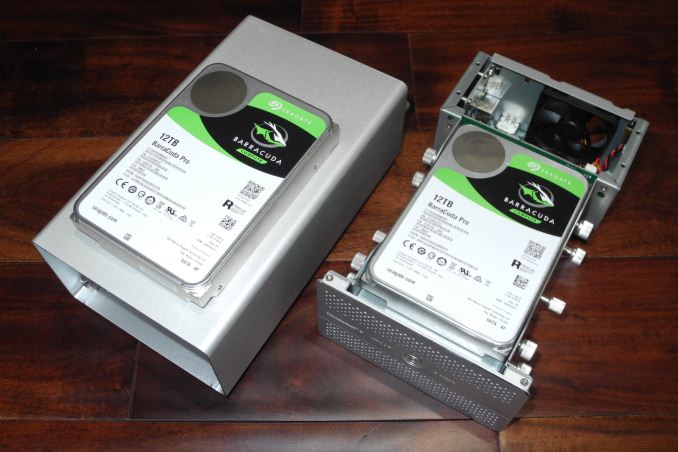Seagate BarraCuda Pro 12TB HDD Review
by Ganesh T S on November 15, 2017 8:00 AM EST- Posted in
- Storage
- Seagate
- HDDs
- Helium HDD
Concluding Remarks
The BarraCuda Pro 12TB is a unique product in the market. It is not often that we see a leading capacity 'desktop-class' hard drive rated for 24x7 operation or workload ratings of 300TB/year. To top it all, Seagate is even throwing in a 5-year warranty. A 2-year data recovery service (DRS) is also included. The lower load/unload cycles rating (300K, compared to the 600K in the equivalent NAS drives) and MTBF (1M hours, compared to 1.2M for the equivalent Pro NAS drive) are slightly disappointing aspects, but, they are more than made up for by the warranty and DRS.
In the gaming desktops market in particular, we are seeing per-game storage requirements running into 100s of GBs, and SSDs continuing to remain above $0.33/GB. Under these circumstances, high-capacity hard drives are bound to become relevant again. In our evaluation, the drive managed to perform quite well for largely sequential workloads (typical of bulk storage requirements in gaming workloads).
Consumers dealing with content creation can also use the BarraCuda Pro as part of a direct-attached storage system. For single-user scenarios, a DAS inherently makes more sense than a NAS. It allows use of enclosures sporting interfaces with higher speeds. The BarraCuda Pro 12TB drive shows great performance in such devices.
In our evaluation, the drive successfully met all of Seagate's claims. Helium drives have achieved economies of scale and are now mass-market devices. The current street price of the BarraCuda Pro 12TB ($500) is already lower than the suggested launch price ($530). The other 12TB Seagate options are the IronWolf NAS drive at $450, IronWolf Pro at $510, and the Enterprise Capacity at $469. We also have the Western Digital WD Gold at $522. The IronWolf has a lower workload rating (180 TB/yr vs 300 TB/yr) and also doesn't have the data recovery service available with the BarraCuda Pro and the IronWolf Pro. None of the enterprise drives carry the DRS option, which justifies the premium associated with the two Seagate Pro drives.
Pricing the BarraCuda Pro mid-point between the IronWolf and the IronWolf Pro would have made it an obvious choice for a high-capacity desktop / DAS usage drive. As it currently stands, it is difficult to choose between the IronWolf Pro and the BarraCuda Pro, as only $10 separates them. The IronWolf Pro also has a higher load/unload cycle rating. Seagate claims that the firmware in the BarraCuda Pro is tuned specifically for typical high-end desktop workloads. However, it is unlikely that consumers will see obvious performance differences between the two drives in typical single-user scenarios. In the end, the DRS ensures that customers are unlikely to go wrong with either the IronWolf Pro or the BarraCuda Pro, irrespective of the end application.












62 Comments
View All Comments
rtho782 - Wednesday, November 15, 2017 - link
I'd rather loose a 12TB Plex Library than a 100kB bitcoin wallet with 10 bitcoins in.The size of the data isn't really relevant.
BurntMyBacon - Wednesday, November 15, 2017 - link
@Glock24: "Who wants to lose 12TB of data? Yeah, not me."You will only loose as much data as you have stored on the drive. If you only have 3TB data, then it doesn't matter whether it's a 12TB drive or a 6TB drive (assuming the same failure rate). If you do have 12TB of data, then you'll need several smaller drives to hold that data (2x6TB, 3x4TB, etc.). That presents a trade-off for data protection. While a single catastrophic (total) drive failure won't take all your data with it, you've massively increased the probability of a catastrophic drive failure taking place. Then there's the fact that not all your data is of equal value. If Murphy has anything to say about it, it will be your most valuable data that gets lost. So all going with smaller really does is reduce the severity of a data loss (due to total drive failure) at the expense of increasing the certainty of data loss (and that data possibly being your most valuable data).
So, as kingpotnoodle said, have a backup plan in place. Redundancy via RAID1 (or other RAID not 0) is good practice for data protection. Also, if you are so inclined, you can use a file system that has built in redundancy features (I.E. ZFS) and store two or more copies of files on different parts of the drive. This would reduce the amount of data able to be stored on the drive, but significantly increase data resilience from failures that aren't total drive failures. It also makes data recovery more likely in the case of total drive failure.
In short, a 12TB drive can be both less likely to loose data and have no more data to lose than a 4TB drive if you set it up that way (ZFS or similar with triple redundancy at the file system level). Of course, this comes at the expense of cash, just like any other data redundancy solution (I.E. RAID1), so choose your methods wisely.
Arbie - Wednesday, November 15, 2017 - link
I suppose it can be sussed out of the performance data, but... can you please say if this drive is shingle technology or not? With any Seagate drive that's one of my first questions, and they seem to have stopped identifying it in the literature.ganeshts - Wednesday, November 15, 2017 - link
I already clarified in the introductory text with an edit, and also in a comment below - these are NOT shingled drives, but PMR platters in a sealed helium-filled enclosure.Fallen Kell - Wednesday, November 15, 2017 - link
Exactly. Now one thing that isn't being mentioned that is very important as we get into these bigger and bigger hard drives within use in RAID systems is the time to rebuild and single read failure rates. That 12TB drive in full use on a RAID 5 system will take over 18 hours just to read the other disks inside the RAID group, factor in 14 hours to write the parity data to the new disk and give a 10% overhead for calculating the parity, and you are looking at around 36 hours assuming no other activity is happening on the RAID set to rebuild from a failed disk. If during those 36 hours a single read failure occurs (on a RAID 5), you have just lost all your data.This is why as has been stated that things like RAID 6 has been developed, but we are now pushing the boundaries of what RAID 6 can protect against, and really need to be using RAID 5+1 or similar, but that costs double the amount of hard drives to implement.
wumpus - Thursday, November 16, 2017 - link
These issues have mostly been proven to be overkill, but I doubt I'd trust even Seagates even in RAID 6 (and then some) [having two arrays of RAID 5 means your software is a kludge. That's just fundamentally stupid and you should be really looking into some sort of Reed-Solomon based system with many ecc drives. But unfortunately "known good RAID 5" beats "insufficiently tested reed solomon encoding" so I understand how it gets used. Doesn't make it any less of a kludge] .Also remember that the bit error rate of 10^15 doesn't mean "expect 1 bit every 10^15 read/writes" but really "expect an aligned 4kbyte of garbage every 8*4096*10^15", so the calculations are a bit different. The internals of hard drives mean either the whole sector is good or it is entirely garbage, you don't individual bit errors.
And if "you just lost all your data" really happens, you have a pretty strange dataset that can't take a single aligned 4k group of garbage (most filesystems store multiple copies of critical data, so that wouldn't be an issue).
Even if you did, you would just break out the tapes and reload (which unfortunately is much, much longer than 36 hours). When *arrays* of 12TB make sense, you are definitely in tape backup land. Hopefully you have a filesystem/backup system that can tag the error to the file (presumably to the RAID sector size) and simply reload the failed RAID sector from tape (because otherwise you will be down for weeks).
GreenReaper - Sunday, September 2, 2018 - link
I think your sums are a little off - it doesn't have to be a serial operation. A good RAID solution will rebuild by reading and writing at the same time. However, I/O contention on reads *can* kill a rebuild, and this can easily turn an operation which "should" take a day into a week-long saga.bigboxes - Friday, November 17, 2017 - link
One more time... RAID is not backup. Doesn't matter if you have the drive mirrored. If a file gets corrupted/deleted on one drive, then you have the same issue on the mirrored drive.Pinn - Thursday, November 16, 2017 - link
Store less porn, Glock24.Samus - Thursday, November 16, 2017 - link
I'd put my family in a Ford Pinto before I put 12TB of data on a Seagate.